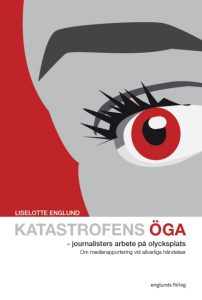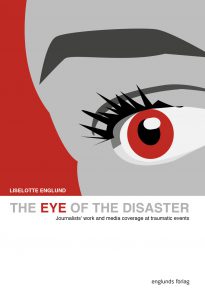SLUTSÅLDA förlagsutgåvor av doktorsavhandlingen Katastrofens öga, på svenska (2008) och engelska (2019).
Katastrofens öga
Journalisters arbete på olycksplats – om medierapportering vid allvarliga händelser (2008)

Medierapportering från olyckor och katastrofer hör till de pressetiskt svåraste uppdragen för en journalist. Boken innehåller en forskningsöversikt över det område som kallas traumajournalistik, och bygger på en professionsstudie som kombinerar perspektiv och teori från i huvudsak journalistik och krispsykologi. Det är en studie av reportrar och fotografer med ett professionellt uppdrag i en extrem situation; som ögonvittnen till en katastrof. Boken redogör för medierapportering vid allvarliga händelser, med fokus på Göteborgsbranden, oktober 1998, som krävde 63 unga människors liv i samband med en privat fest. Reportrar och fotografer kom snabbt till platsen, och flera av dem kom att bli professionella ögonvittnen till det trauma som utspelade sig. Den medierapportering som följde väckte frågor om hur sådan här journalistik egentligen kommer till. Hur påverkas rapporteringen när journalisterna själva blir indirekt drabbade och kämpar med att bemästra sina egna krisreaktioner? Hur fungerar olycksplatsen som arbetsplats för oförberedda och chockade journalister? Vilka bemästringsstrategier använder reportrar och för att orka genomföra sitt uppdrag? Och vad kan vi i framtiden lära av erfarenheter från den här typen av händelser?
Katastrofens Öga (som är en doktorsavhandling) vilar också på tidigare forskning om olyckor och katastrofer, i synnerhet studier av reaktioner hos insatspersonal under arbete vid allvarliga händelser.
Med den tragiska brandkatastrofen som fallstudie intervjuas reportrar och fotografer vid morgon- och kvällspress om sina upplevelser av olycksplatsen som arbetsplats. Dessutom diskuteras deras självupplevda krisreaktioner och bemästringsstrategier, samt de beslut och handlingar som låg till grund för medierapporteringen. Även arbetsledarnas roll skildras
The Eye of the Disaster
Journalists’ work and media coverage at traumatic events.
English edition (2019) of “Katastrofens öga” (2008).

Journalists who in the line of duty become eyewitness to a traumatic event may face the greatest professional challenge of their lives. Reporting on a disaster involves heavy personal as well as professional pressure. Media organisations are also put to the test, and editors have a special responsibility for published content and for their staff on site. The relationship between media and disaster victims is particularly delicate, and media interaction with rescue and emergency services is also an area of concern.
This book surveys the journalistic task of covering accidents or disasters and includes press ethical principles and psycho-traumatological issues such as stress reactions and coping. The empirical part is based on a disastrous fire at a Halloween party in Gothenburg, Sweden, 1998, in which 63 young people lost their lives and 200 were injured. It is an occupational study based on interviews with Swedish journalists reporting from the scene as well as their editors. The main focus is on the accident site as a workplace in the acute phase, but long-term aspects of individual and collective learning and psychological support are also considered. In addition, a model of journalist roles on a disaster site is presented along with a competence model for disaster journalism.
In the past decade, the Swedish edition of the book has been widely used in journalism undergraduate programs and further training for journalists and disaster actors: emergency services, first responders, communications and crisis teams. This English edition (first available online in 2018) is a translated version of the author’s doctoral thesis, presented at the Department of Journalism, Media and Communication at Gothenburg University and published in Swedish, 2008.
Liselotte Englund holds a doctorate in journalism from Gothenburg University. Since the 1980s she has worked alternately in media and academia in various capacities such as editor at Swedish Radio and Swedish Research Council and independent writer. She was a post doc researcher at the National Centre of Disaster Psychiatry, Uppsala University, and currently she is assistant professor and head of department at Karlstad University, Sweden. In 2010 she received the Frank Ochberg Award for Media and Trauma Study from the International Society for Traumatic Stress Studies (ISTSS).
